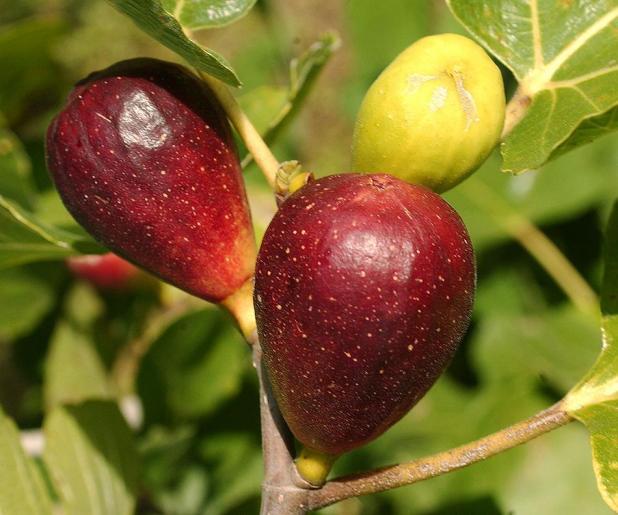
July is fig harvest season
—LSU AgCenter file photo
Take care of lawns, gardens during July heat
July can be a tough month for plants in Louisiana due to heat, high humidity, and increased disease and insect pressure. Despite the heat, some plants still perform well in these conditions.
July is harvest season for figs. These fruit trees grow well in Louisiana with little effort, and the fruit is high in potassium, iron and fiber. The tree also makes a nice landscape tree planting with its large, uniquely lobed leaves, growing best in full sun. Plant in the fall or winter for best establishment.
There are some common fungal disease problems in figs this time of year. Thread blight and fig leaf rust cause leaf spotting and scorch in late summer and fall. There are no EPA-approved fungicides for use on figs in Louisiana. The best way to manage these is with good cultural practices. Plants should be spaced to provide good air circulation and water at the root zone. Remove fallen, infected leaves and throw them away to prevent spread.
In the lawn, you can plant warm-season grasses throughout the summer. Planting in July will provide better opportunities for lawns to become established before going dormant in the winter. You can fertilize Bermuda grass, zoysia and St. Augustine grass lawns in spring for a second application, but it is not recommended to reapply fertilizer for centipede grass.
It’s time to stop using weed killers in the lawn during these hot summer months. Temperatures over 85 degrees will cause injury to the lawns. Chinch bugs and mole crickets are a problem this time of year. Follow pesticide labels and directions to treat.
Mowing will be the most common practice in the home landscape this month. Grasses thrive and grow aggressively in summertime. Be sure to cut your lawn proper heights once a week or every other week depending on growth and rain activity: Bermuda grass, 1-1½ inches; centipede grass, 1-2 inches; St. Augustine grass, 2-3 inches; and zoysia, ½-1½ inches.
Increasing heat and water requirements make planting shrubs and trees this month more challenging; however, container plants can still be installed. Be aware of the need for more frequent watering and fertilizer requirements as plants use water faster when it is hot and they are actively growing.
Do not plant trees and shrubs this month if you can avoid it; especially avoid digging up plants and moving them to new locations. Control aphids on crape myrtles and lace bugs on azaleas and lantanas. For roses, continue a spray program that includes both a fungicide for black spot control and an insecticide to control pests.
In the vegetable garden, it’s time to start your pumpkin seeds. Yes, it’s already time to think about the fall. If you want a pumpkin to carve for Halloween, start with the Oct. 31 date and consider the number of days until harvest for each variety. Average harvest days for pumpkins range from 70 to 120 days. Work backward from there to figure out the best planting date.
Pumpkins last several weeks and can be used to carve jack-o-lanterns for Halloween, for fall decorations and for recipes for Thanksgiving. Pumpkins need a lot of room to grow. They are vines that spread, so plant them 3 to 6 feet apart and on every other row if planting in rows. For smaller bush-type pumpkins, space plants 2 to 3 feet apart.
Giant pumpkin varieties can weigh 80 or more pounds. Recommended varieties are Atlantic Giant, Prize Winner, Big Moon and Big Max.
Large varieties are 10 to 30 pounds and include Aspen, Howden, Spirit (AAS), Gold Rush, Cargo, Connecticut Fields and Jumpin Jack. New Moon and Lumina are both white.
Medium-sized varieties pumpkins are 5 to 10 pounds. They include Autumn Gold, Big Autumn, Charisma, Cougar, Jack-o-Lantern, Neon and Peek a Boo (AAS winner). Cougar is bright orange and was the second pick at yield in field trials by the LSU AgCenter. Charisma is round and bright orange and was the fourth top yielding pumpkin during 2016 field trials.
Small-sized pumpkins are Early Abundance (yellow), Darling, and Sunlight (yellow to white). Variety trials conducted in 2016 found Sunlight was the top yielding variety. Early Abundance came in second, and Darling was third. Also try Baby Bear, Casperita and Gooligan (white), Hooligan and Jack Be Little.
Irrigation is necessary for a good pumpkin crop. Smaller pumpkins tend to grow better in Louisiana. Wait to harvest until fruit is mature and their characteristic color with rinds that are hard to pierce. Cut from the vines, leaving a 3- to 5-inch stem attached to improve shelf life and make pumpkins more attractive.
Lastly, plant heat-set tomatoes and bell peppers for fall harvest. Direct-seed okra, southern peas, cucumbers, squash, cantaloupe and watermelons throughout July and order fall vegetable garden seeds including; broccoli, Brussels sprouts, cauliflower, Chinese cabbage, cabbage, leafy greens and all your root crop seeds.
